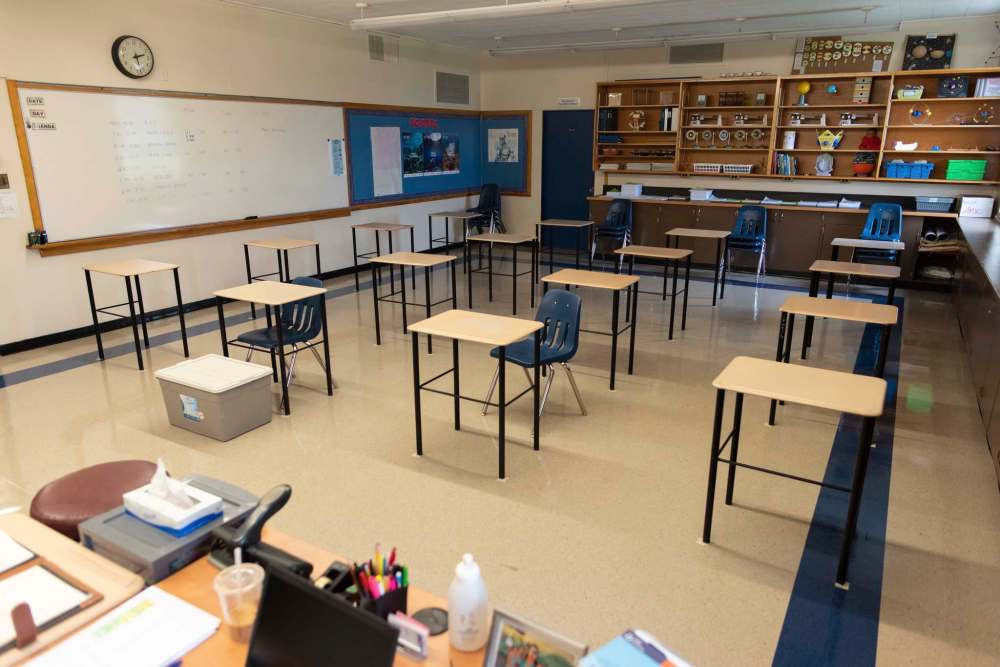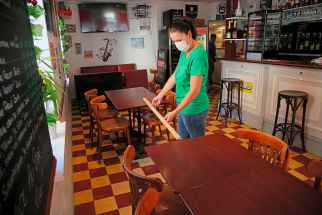Winnipeg teachers in constant state of anxiety amid pandemic Educators' coping levels relative to stress is at an all-time low, study finds
Read this article for free:
or
Already have an account? Log in here »
To continue reading, please subscribe:
Monthly Digital Subscription
$0 for the first 4 weeks*
- Enjoy unlimited reading on winnipegfreepress.com
- Read the E-Edition, our digital replica newspaper
- Access News Break, our award-winning app
- Play interactive puzzles
*No charge for 4 weeks then price increases to the regular rate of $19.00 plus GST every four weeks. Offer available to new and qualified returning subscribers only. Cancel any time.
Monthly Digital Subscription
$4.75/week*
- Enjoy unlimited reading on winnipegfreepress.com
- Read the E-Edition, our digital replica newspaper
- Access News Break, our award-winning app
- Play interactive puzzles
*Billed as $19 plus GST every four weeks. Cancel any time.
To continue reading, please subscribe:
Add Free Press access to your Brandon Sun subscription for only an additional
$1 for the first 4 weeks*
*Your next subscription payment will increase by $1.00 and you will be charged $16.99 plus GST for four weeks. After four weeks, your payment will increase to $23.99 plus GST every four weeks.
Read unlimited articles for free today:
or
Already have an account? Log in here »
Hey there, time traveller!
This article was published 16/10/2020 (1879 days ago), so information in it may no longer be current.
On any given school day, Anya has two 30-minute slots without her middle school students.
Prep periods are typically for lesson planning, photocopying and marking assignments, among other teacher to-do list items.
Since the start of the school year, Anya — which is not the longtime teacher’s real name — has also been using the time to “tailgate.” That’s what she and a colleague have come to call parking on a street near their school and sobbing.
“It’s either your car or your classroom,” she said, after a recent school day.
***
Ever-changing COVID-19 scenarios and related public health restrictions have put teachers on standby-mode since mid-March. The sudden spring pivot to remote instruction and a summer of uncertain planning fuelled anxiety. Now, autumn classes with physical distancing, masking and recovery learning are doing the same.

A new University of Winnipeg study of 2,200 Canadian teachers indicates educators’ coping levels, relative to stress, is at an all-time deficit since the pandemic disruptions started.
“The current teaching situation (30 per cent deficit) is more stressful than at the early shift to remote teaching,” said Laura Sokal, a professor of education at U of W, who has co-conducted three surveys of teachers’ coping strategies, in late April, early June and late September, respectively.
The Free Press spoke to seven Winnipeg teachers — all of whom spoke on the condition of anonymity, for fear of retribution at work — about how they are coping, given the ever-changing protocols, reconfigured classrooms and health risks of entering a building with hundreds of people inside daily.
While school has not yet proven to be a widespread superspreader event, each teacher shared similar concerns in describing unparalleled stress during this back-to-school season, with community transmission and case counts on the rise.
Division media policies
No matter their employer, teachers across Winnipeg are typically required to get media approval before they can speak to a reporter.
The seven teachers who spoke to the Free Press about their anxieties during this atypical school year all expressed fear about speaking out. Each source asked for anonymity.
“We’re muzzled to speak about our work environments,” said Misha, a Winnipeg resource teacher who is on an indefinite stress leave, owing to the COVID-19 disruptions. (Misha is not her real name.)
“If you talk, we can start making change, we can start supporting each other.”
No matter their employer, teachers across Winnipeg are typically required to get media approval before they can speak to a reporter.
The seven teachers who spoke to the Free Press about their anxieties during this atypical school year all expressed fear about speaking out. Each source asked for anonymity.
“We’re muzzled to speak about our work environments,” said Misha, a Winnipeg resource teacher who is on an indefinite stress leave, owing to the COVID-19 disruptions. (Misha is not her real name.)
“If you talk, we can start making change, we can start supporting each other.”
The teachers work in different divisions across the city, but the anxieties they shared were the same — both about their school day stresses and coming forward about them.
In Winnipeg’s six school divisions, reporters are asked to contact official spokespeople about media inquiries.
At the River East Transcona School Division, reporters are asked to contact a communications officer to “do checks” regarding media clearance.
“Our administrators and teachers are busy people who make educating our students their first priority,” states the northeast division’s website.
According to Pembina Trails School Division’s media relations policy, school employees may speak to news media with the approval of school administration — “but only within the scope of their responsibility and knowledge.”
In their words, COVID-19 has resulted in “chaos,” “burnout,” and “sheer exhaustion” at work.
Several teachers teared up during interviews. Two of them are on indefinite stress leave because of their mental health.
“We were all looking forward to going back and having a little bit of normal, but it’s anything but normal,” said Linda, an elementary teacher in Winnipeg. “It’s exhaustion, to the point where sometimes you just want to take a nap before you drive home so you can take a break.”
No matter how late Linda stayed after school during September, she said she never felt she could keep up with the planning required to teach during a pandemic.
Before the new year even began, Misha’s doctor prescribed a leave. The resource teacher said she could not function — unable to eat, make dinner for her family or get motivated to do anything else — for three weeks after the final bell rang in June.
“Communication has been so weak between the province and the divisions and individual teachers that they live in constant state of anxiety about what could be happening tomorrow in their classrooms,” she said.
***
For Alex, the problem is reopening plans have been “a complete paradox.”
The Winnipeg teacher said the public is being misled about what’s happening in schools. While cohorts exist, masks are required and breaks are scheduled so students don’t cross paths in the hallway, students in different classes intermingle before school, during lunch and after school, she said.
Alex said specialized teachers also move from class to class and students from different cohorts see guidance counsellors, a practice that disregards strict cohorting. “If A is connected to B and A is connected to C, then B and C are also connected,” the teacher added.

Elementary music teacher Leila, who works in two schools, estimates she has nearly 300 close contacts through work.
Leila said her weekly work hours have increased by 50 per cent this year, to 60 hours weekly, to make time to brainstorm lesson plans that don’t involve singing, which her division has banned indefinitely. The prospect of switching to remote learning this year is the biggest stressor of all, she said, adding it isn’t easy to teach music through a screen.
For others, major anxieties lie in what have become known as a duplex, triplex or quadruplex classrooms. These setups ensure desks can be spaced out by two metres.
Charlotte and two colleagues, a teacher and an educational assistant at her school, are working out of three classrooms. The trio teaches close to 50 students across the spaces, taking turns alternating between students throughout the school day.
Since the educational assistant cannot instruct students, the other two have been putting together substitute teacher plans for their colleague daily.
“We’re missing at least a third of the time that we should be getting with our kids because that third of the time can’t be instructional time,” Charlotte said. “It’s been an exorbitant amount of work.”
***
At U of W, Sokal and her colleague Lesley Trudel polled teachers, not only about what is causing them stress, but also how to alleviate it.
Key themes from the September survey include teachers wanting to receive clear messaging from within education instead of hearing developments through news outlets, and have their experiences listened to and valued.
“There needs to be that recognition of just how hard these teachers are working,” said James Bedford, president of the Manitoba Teachers’ Society, which includes upwards of 16,000 public school educators.

“It’s about keeping themselves safe, keeping their students safe and then, they go home at night and the pandemic isn’t left behind,” he said. “It’s incredibly difficult to keep up that.”
The teachers who spoke to the Free Press shared in their belief class sizes should be adjusted, more teachers hired and tough times acknowledged to improve the stressful situation that is working in a classroom during a pandemic.
Leila, who teaches music, said she wants administrators to forgo “toxic positivity” and recognize teachers are struggling right now.
“Everyone needs to take a deep breath and take time to listen to their peers, listen to your colleagues. Don’t tell them everything is going to be great. It’s OK to say, ‘I’m having a hard time, you too?’ It’s OK to commiserate. Acknowledge it,” she said.
Addison, a high school teacher, said she would like to see class sizes shrink to ensure physical distancing is truly in place in her classroom. Right now, she said her teenage students are “barely” one metre apart.
Addison and her colleagues had minimal time to prepare for the unprecedented year, having been given their classroom assignments the Friday before Labour Day.
“I have over 20 years teaching and I feel like I’m a first year teacher, just barely making it through the day, and everybody feels like that. Everybody’s stressed,” she said, before tearing up during an interview.
“I don’t know how we’re going to make it to Christmas, really.”
maggie.macintosh@freepress.mb.ca
Twitter: @macintoshmaggie

Maggie Macintosh reports on education for the Winnipeg Free Press. Funding for the Free Press education reporter comes from the Government of Canada through the Local Journalism Initiative.
Our newsroom depends on a growing audience of readers to power our journalism. If you are not a paid reader, please consider becoming a subscriber.
Our newsroom depends on its audience of readers to power our journalism. Thank you for your support.





.jpg?h=215)

